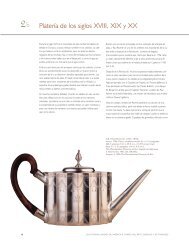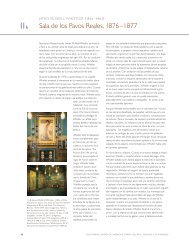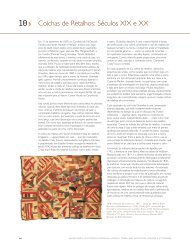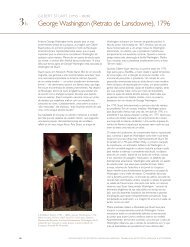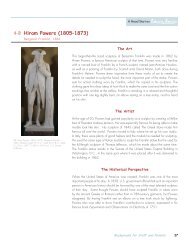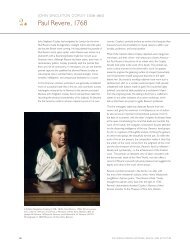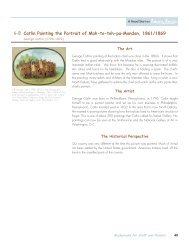Robert Shaw Memorial, 1884-1897, Augustus - Picturing America
Robert Shaw Memorial, 1884-1897, Augustus - Picturing America
Robert Shaw Memorial, 1884-1897, Augustus - Picturing America
You also want an ePaper? Increase the reach of your titles
YUMPU automatically turns print PDFs into web optimized ePapers that Google loves.
10 a<br />
44<br />
AUGUSTUS SAINT-GAUDENS [1848–1907]<br />
<strong>Robert</strong> <strong>Shaw</strong> <strong>Memorial</strong>, <strong>1884</strong> –<strong>1897</strong><br />
The <strong>Robert</strong> Gould <strong>Shaw</strong> and the Fifty-fourth Regiment <strong>Memorial</strong>,<br />
a monumental bronze relief sculpture standing at the edge of<br />
Boston Common, was begun twenty years after the end of<br />
the Civil War and not completed for another fourteen. It was<br />
an unusually complex project, but the sculptor, <strong>Augustus</strong> Saint-<br />
Gaudens, came to regard it as a labor of love. The memorial<br />
had been commissioned by a group of Bostonians to honor<br />
Colonel <strong>Robert</strong> Gould <strong>Shaw</strong>, the privileged son of abolitionist<br />
parents, who had given his life fighting for the Union cause.<br />
Saint-Gaudens originally envisioned an equestrian statue —<br />
the traditional hero on horseback — but <strong>Shaw</strong>’s family objected<br />
to the format as pretentious. The revised design presents the<br />
officer riding beside a company of foot soldiers marching<br />
toward their destiny. When the monument was at last unveiled<br />
in <strong>1897</strong>, the philosopher William James observed that it was<br />
the first <strong>America</strong>n “soldier’s monument” dedicated to a group<br />
of citizens united in the interests of their country, rather than<br />
to a single military hero.<br />
<strong>Robert</strong> <strong>Shaw</strong> commanded the Fifty-fourth Massachusetts<br />
Volunteer Infantry. It was the first regiment of African <strong>America</strong>ns<br />
recruited in the North for service in the Union Army. Many<br />
of the volunteers had enlisted at the urging of the black orator<br />
Frederick Douglass, who believed (mistakenly, as it turned out)<br />
that former slaves and others of African descent would never<br />
be denied the full privileges of citizenship if they fought for those<br />
rights alongside white <strong>America</strong>ns. But arming black soldiers in<br />
defense of the Republic proved to be controversial and the Fiftyfourth<br />
bore the additional burden of having to prove its value.<br />
In the summer of 1863, <strong>Shaw</strong>’s regiment led an audacious<br />
assault on Fort Wagner, South Carolina. That fortress on<br />
10-A <strong>Augustus</strong> Saint-Gaudens (1848–1907), <strong>Robert</strong> Gould <strong>Shaw</strong> and the Fifty-fourth<br />
Regiment <strong>Memorial</strong>, Beacon and Park streets, Boston, Massachusetts, <strong>1884</strong>–<strong>1897</strong>.<br />
Bronze, 11 x 14 ft. (3.35 x 4.27 m.). Photograph by Carol M. Highsmith.<br />
Morris Island guarded Charleston Harbor, the principal port<br />
of the Confederacy, and was built on earthen parapets that<br />
rose thirty feet above the beach. It had only one land-facing<br />
side, which was bordered with a water-filled ditch ten feet<br />
wide. <strong>Shaw</strong>’s battalions were already weakened and exhausted<br />
when they approached Fort Wagner on July 18, after a grueling<br />
two-day march through driving rain. And as their commanding<br />
officer would have known, the attack was doomed before it<br />
began, for the Union troops were overwhelmingly outnumbered<br />
by Confederates. Nevertheless, <strong>Shaw</strong> rode into battle<br />
flourishing his sword and shouting “Forward, Fifty-fourth!” As<br />
he crested the ramparts, three enemy bullets shot him down.<br />
His body was later stripped and thrown with those of his<br />
troops into a mass grave.<br />
In the end, 281 soldiers and officers from the unit were lost at<br />
Fort Wagner — killed or never accounted for — and countless<br />
others were injured. Despite that dramatic defeat, the<br />
Massachusetts Fifty-fourth had successfully “established its reputation<br />
as a fighting regiment,” in the words of one of its surviving<br />
officers, Frederick Douglass’s son Lewis: “Not a man flinched.”<br />
Reports of their extraordinary courage rallied African <strong>America</strong>ns<br />
to the cause, and Abraham Lincoln later surmised that the additional<br />
manpower they supplied had made the critical difference<br />
to the outcome of the war.<br />
Saint-Gaudens symbolized this paradoxical military episode in<br />
which defeat gives rise to victory with the winged figure that<br />
hovers in low relief above the soldiers; she carries poppies,<br />
traditional emblems of death and remembrance, and an olive<br />
branch for victory and peace. Apart from that concession to<br />
allegory, Saint-Gaudens worked in a realistic style. If the portrait<br />
of <strong>Shaw</strong> appears idealized, his rigid posture and resolute gaze<br />
nonetheless accord with contemporary accounts of his brave<br />
demeanor as he entered battle like a sacrificial lamb. More<br />
remarkable is the stoic procession of soldiers, portrayed not as<br />
cogs in the machinery of war but as individuals participating in a<br />
moral crusade. In a time when African <strong>America</strong>ns were usually<br />
depicted as generic types, Saint-Gaudens searched out models<br />
and produced some forty portrait-heads in clay, even though<br />
he used only sixteen in the sculpture itself. The ragged uniforms<br />
of the recruits are each disheveled in a different way — not to<br />
undermine the soldier’s gallantry, as some have argued, but<br />
to recall their long and dreary trudge to Charleston Harbor.<br />
“There they march,” said William James, “warm-blooded<br />
champions of a better day for man.”<br />
In 1982, sixty-two names of African <strong>America</strong>n soldiers who<br />
gave their lives at Fort Wagner were inscribed on the base of<br />
the <strong>Shaw</strong> <strong>Memorial</strong>.<br />
PICTURING AMERICA ARTWORK, ESSAYS, AND ACTIVITIES
TEACHING ACTIVITIES<br />
E = ELEMENTARY|M = MIDDLE|S = SECONDARY<br />
DESCRIBE AND<br />
ANALYZE<br />
INTERPRET<br />
Encourage students to look closely at all the details<br />
in this sculpture.<br />
E|M<br />
Ask students to find a drum. It is on the far right. Where are the flags? They are on the left, behind the rifles.<br />
E|M|S<br />
Have students look closely at the individual faces. Which ones wear mustaches and beards?<br />
E|M|S<br />
How are the foot soldiers dressed?<br />
They wear caps, long-sleeve shirts, shoes, and long pants, and they carry canteens.<br />
What do they carry on their backs? They shoulder bed rolls and packs.<br />
What else do they carry? They carry rifles.<br />
Compare the foot soldiers’ dress with Colonel <strong>Shaw</strong>’s.<br />
Both wear caps with visors, but the foot soldiers’ hats are more wrinkled. <strong>Shaw</strong> wears a long jacket and boots.<br />
What does <strong>Shaw</strong> hold? He holds a sword in one hand and his horse’s reins in the other.<br />
E|M|S<br />
Have students discuss how artists can create rhythm in works of visual art. How did Saint-Gaudens create a sense of<br />
rhythm in this relief?<br />
He repeated the slant of leg and body lines and shapes at regular intervals across the sculpture. (Even the horse’s legs match the<br />
slant of the marching soldiers’ legs.) The repeated rifles create a steady rhythm in the top half of the sculpture. Only <strong>Shaw</strong>’s<br />
upright form and his horse’s neck interrupt the steady march across the sculpture.<br />
E|M|S<br />
How did Saint-Gaudens create a sense of depth in this sculpture? How do you know that some soldiers are closer to<br />
viewers than others?<br />
Soldiers who are closer to us stand out farther from the background; they are in greater relief. The soldiers at the back are in low<br />
relief. The closer forms also overlap the more distant ones.<br />
Which figure is closest to the viewer (in highest relief)? <strong>Robert</strong> <strong>Shaw</strong> is.<br />
E|M|S<br />
Who is in command? The man on the horse, Colonel <strong>Shaw</strong>, is.<br />
How do you know? As the only mounted figure, he is above the other soldiers; he carries a sword, and his jacket has the fancy<br />
cuffs of an officer’s uniform. Also, the title tells us that this honors <strong>Robert</strong> <strong>Shaw</strong>.<br />
E|M|S<br />
This was commissioned to honor and remember <strong>Robert</strong> <strong>Shaw</strong>, but who else does it commemorate?<br />
It honors the foot soldiers of the Fifty-fourth Massachusetts Volunteer Infantry.<br />
M|S<br />
Ask why students think this monument was made of bronze rather than marble or wood.<br />
Bronze lasts longer outside; it reflects light and is dark and solemn. It can be worked in minute detail, and thin forms like rifles and<br />
reins do not break easily.<br />
S<br />
What does the winged figure in the sky hold? She holds poppies and an olive branch.<br />
What do you think this figure in the sky represents? Why?<br />
She may represent an angel. The poppies usually symbolize death and remembrance, and the olive branch, peace and victory.<br />
Remind students that artificial poppies are worn on Veterans Day to remember <strong>America</strong>’s war veterans.<br />
CONNECTIONS Historical Connections: Civil War;<br />
Massachusetts Fifty-fourth Regiment;<br />
Abolitionists; Bloody Kansas; John<br />
Brown’s Raid on Harper’s Ferry;<br />
Underground Railroad<br />
Historical Figures: <strong>Robert</strong> Gould<br />
<strong>Shaw</strong>; Frederick Douglass; John<br />
Brown; Harriet Tubman; Sojourner<br />
Truth; William Lloyd Garrison<br />
Geography: James Island, S.C.; Morris<br />
Island, S.C. (the battle at Fort Wagner,<br />
ROBERT SHAW MEMORIAL, <strong>1884</strong>–<strong>1897</strong>, AUGUSTUS SAINT-GAUDENS [1848–1907]<br />
also called Battery Wagner);<br />
Charleston Harbor (principal<br />
port of the Confederate Army)<br />
Literary Connections and Primary<br />
Documents: Frederick Douglass: The<br />
Black Lion, Patricia McKissack<br />
(elementary); Walking the Road to<br />
Freedom: A Story about Sojourner Truth,<br />
Jeri Ferris (elementary); Uncle Tom’s<br />
Cabin, Harriet Beecher Stowe (middle,<br />
secondary); “Frederick Douglass” and<br />
“Harriet Beecher Stowe,” Paul<br />
Lawrence Dunbar (middle); “For<br />
the Union Dead,” <strong>Robert</strong> Lowell<br />
(secondary); Narrative of the Life of<br />
Frederick Douglass, Frederick Douglass<br />
(secondary); Booker T. Washington’s<br />
speech at the unveiling of the <strong>Shaw</strong><br />
<strong>Memorial</strong> (<strong>1897</strong>) (secondary)<br />
Arts: relief sculpture; beaux-arts<br />
movement; <strong>America</strong>n Renaissance<br />
teaching activities<br />
45



